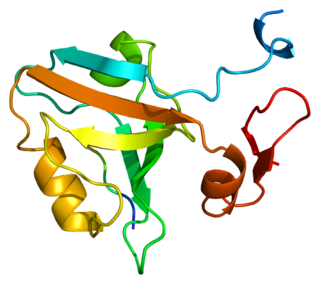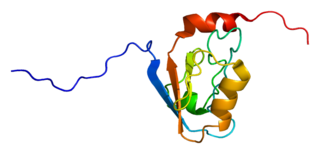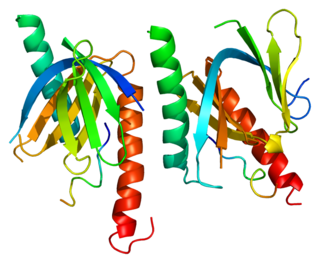
The Kir2.1 inward-rectifier potassium channel is a lipid-gated ion channel encoded by the KCNJ2 gene.

PSD-95 also known as SAP-90 is a protein that in humans is encoded by the DLG4 gene.

Peripheral plasma membrane protein CASK is a protein that in humans is encoded by the CASK gene. This gene is also known by several other names: CMG 2, calcium/calmodulin-dependent serine protein kinase 3 and membrane-associated guanylate kinase 2. CASK gene mutations are the cause of XL-ID with or without nystagmus and MICPCH, an X-linked neurological disorder.

Disks large homolog 3 (DLG3) also known as neuroendocrine-DLG or synapse-associated protein 102 (SAP-102) is a protein that in humans is encoded by the DLG3 gene. DLG3 is a member of the membrane-associated guanylate kinase (MAGUK) superfamily of proteins.

Disks large homolog 2 (DLG2) also known as channel-associated protein of synapse-110 (chapsyn-110) or postsynaptic density protein 93 (PSD-93) is a protein that in humans is encoded by the DLG2 gene.

Amyloid beta A4 precursor protein-binding family A member 1 is a protein that in humans is encoded by the APBA1 gene.

G protein-activated inward rectifier potassium channel 2 is a protein that in humans is encoded by the KCNJ6 gene. Mutation in KCNJ6 gene has been proposed to be the cause of Keppen-Lubinsky Syndrome (KPLBS).

Potassium inwardly-rectifying channel, subfamily J, member 4, also known as KCNJ4 or Kir2.3, is a human gene.

Beta-2-syntrophin is a protein that in humans is encoded by the SNTB2 gene.

ATP-sensitive inward rectifier potassium channel 12 is a lipid-gated ion channel that in humans is encoded by the KCNJ12 gene.

Beta-1-syntrophin is a protein that in humans is encoded by the SNTB1 gene.

G protein-activated inward rectifier potassium channel 1(GIRK-1) is encoded in the human by the gene KCNJ3.

Actin binding LIM protein 1, also known as ABLIM1, is a protein which in humans is encoded by the ABLIM1 gene.

MAGUK p55 subfamily member 6 is a protein that in humans is encoded by the MPP6 gene.

Potassium inwardly-rectifying channel, subfamily J, member 15, also known as KCNJ15 is a human gene, which encodes the Kir4.2 protein.

Lin-7 homolog A is a protein that in humans is encoded by the LIN7A gene.

Lin-7 homolog B is a protein that in humans is encoded by the LIN7B gene.

Potassium inwardly-rectifying channel, subfamily J, member 16 (KCNJ16) is a human gene encoding the Kir5.1 protein.

Guanine nucleotide-binding protein G(I)/G(S)/G(O) subunit gamma-T2 is a signalling protein protein that in humans and vertebrates is encoded by the GNGT2 gene. Either GNGT1 or GNGT2 is the gamma subunit of the Gβγ part of transducin, a heterotrimeric G-protein naturally expressed in vertebrate retina rod and cone cell of the eye, where it is thought to play a crucial role in phototransduction. GNGT2 only occurs in cone cells, and GNGT1 only occurs in rod cells.

G protein-activated inward rectifier potassium channel 3 is a protein that in humans is encoded by the KCNJ9 gene.

























